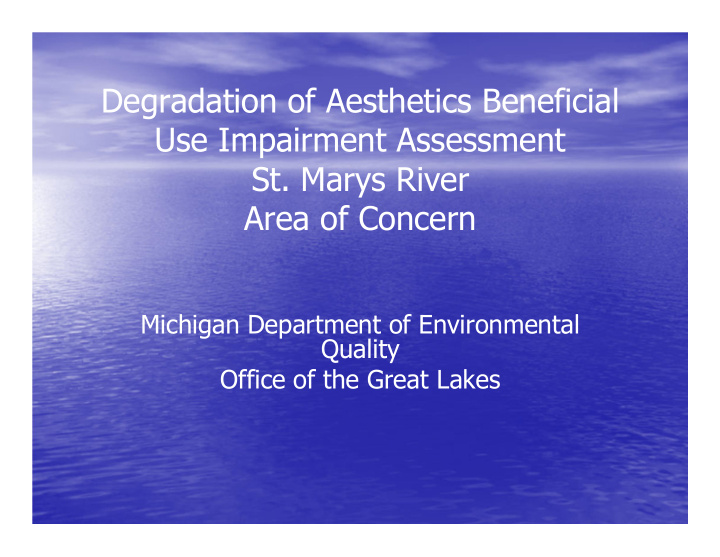



Degradation of Aesthetics Beneficial Use Impairment Assessment St. Marys River Area of Concern Michigan Department of Environmental Quality Office of the Great Lakes
Statewide Assessment of 10 AOCs Two cycles of assessments completed. Staff included: � AOC Coordinator � Aquatic Biologist � Aesthetics Assessment Coordinator � and followed the DEQ � s � 2011 Statewide Aesthetics Assessment Workplan and Monitoring Protocol. �
Aesthetics BUI Restoration Criteria According to the Guidance for Delisting Michigan � s Great Lakes Areas of Concern , this BUI will be considered restored when monitoring data for two successive monitoring cycles indicates that water bodies in the AOC do not exhibit persistent, high levels of the following physical properties in unnatural quantities which interfere with any designated use: � turbidity � oil films � foams � suspended solids � color � floating solids � settleable solids � deposits
Restoration Criteria cont � d For the purposes of the criteria, these eight properties impair aesthetic values if they are unnatural � meaning those that are manmade (e.g., garbage, sewage), or natural properties which are exacerbated by human-induced activities. Persistent, high levels are those defined as long enough in duration, or elevated to the point of being injurious, to any designated use listed under Rule 323.1100 of the Michigan WQS.
Designated Uses As Defined by the Michigan Water Quality Standards Rule 323.1100 (a) Agriculture. (b) Navigation. (c) Industrial water supply. (d) Warmwater fishery. (e) Other indigenous aquatic life and wildlife. (f) Partial body contact recreation. (g) Fish consumption. (h) Total body contact recreation from May 1 to October 31. (i) Public water supply. (j) Coldwater fishery, depending on location. (k) Trout streams, etc.
Site Selection Based on � � Historic documents � According to the 1992 RAP document, nuisance levels of floating material have been periodically reported along the north shore of Sugar Island in the Lake George Channel (OMOE and MDNR, 1992). In addition to nuisance floating scum, the East End WWTP and Algoma Steel were identified as the major point sources contributing to oil and grease to the river, followed by St. Marys Paper (EC et al., 2002). � Consultation with BPAC � DEQ AOC Coordinator best professional judgment � Access
St. Marys River Assessment Locations August 3, 2011 & May 23, 2012
Photos
Assessment Results About 38 photos and 18 water samples were taken. Water samples were consistently clear with low turbidity. Trash and other floating/washed up debris were minimal. Concrete blocks used for shoreline stabilization near Elks Club. Wooden debris observed during low water in Ashmun Bay. Waterfowl were observed, as were minnows and submerged aquatic plants. No evidence of any impairment to a designated use was found. The DEQ recommends removal of the Degradation of Aesthetics BUI and requests a letter of support from the Binational Public Advisory Council to accompany other documentation to EPA.
What the Results Mean � While there still may be occasional aesthetic issues, the St. Marys River AOC is comparable to other non-AOC areas in the state. � It does not mean that the St. Marys River AOC has been restored to pristine conditions.
BUI Removal Process 1. Removal Recommendation document to be prepared 2. BPAC concurs with removal 3. Public Notice proposed removal 4. Public Meeting may be held 5. Recommendation forwarded to EPA GLNPO for concurrence and official removal
Questions? Comments Concerns? Discussion? Contact: John Riley, Office of the Great Lakes, MDEQ (517) 335-4122 rileyj2@michigan.gov
Recommend
More recommend